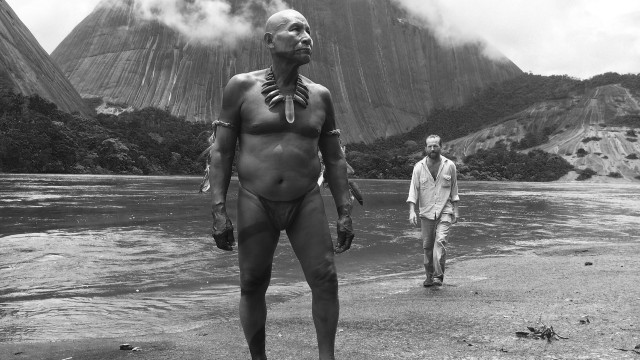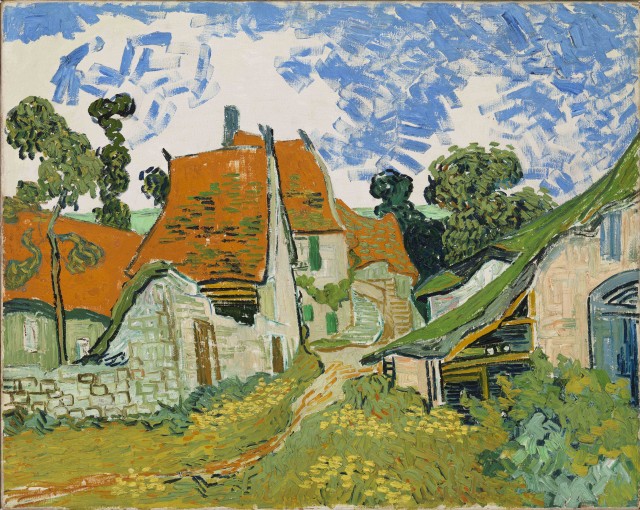
Vincent van Gogh, “Street in Auvers-sur-Oise,” oil on canvas, 1890 (Ateneum Art Museum, Finnish National Gallery, Helsinki, Collection Antell)
The Met Breuer
945 Madison Ave. at 75th St.
Tuesday – Sunday through September 4, suggested admission $12-$25
212-731-1675
www.metmuseum.org
In Mr. Turner, Mike Leigh’s 2014 biopic about British artist J. M. W. Turner, the controversial landscape painter (played with a splendid curmudgeonly gruffness by Timothy Spall) examines a canvas of his hanging at the Royal Academy, approaches it with his brush, and dabs on one last bit of color, as if adding a period to complete the painting. But what really determines whether a work of art is finished? That is the question asked by the Met Breuer in its inaugural exhibition, “Unfinished: Thoughts Left Visible.” The show, which features nearly two hundred paintings, drawings, and sculptures, explores various aspects of completion while referencing the Met’s takeover of Marcel Breuer’s building, originally built for the Whitney, which recently moved to its new home in the Meatpacking District. (At the very least, the downstairs of the Met Breuer has not been finished.) “A work is complete if in it the master’s intentions have been realized,” Rembrandt said. However, Pablo Picasso asserted, “To finish a picture? What nonsense! To finish it means to be through with it, to kill it, to rid it of its soul.” The exhibition, spread across two floors, includes several canvases by Rembrandt and Picasso as well as works by Titian, Pollock, Velázquez, Monet, Homer, Whistler, Friedrich, Hesse, Gericault, Ruscha, Bourgeois, Cézanne, Sargent, Matisse, Szapocznikow, Tuymans, Richter, Johns, Twombly, Dumas, and many others, from the Renaissance to the present, a fascinating journey into the creative process. But the majority of the pieces on view — divided into such sections as “The Infinite: Art Out of Bounds,” “To Be Determined: Painting in Process,” and “Decay, Dwindle, Decline” — are not immediately identifiable as being incomplete, especially given curators Andrea Bayer, Kelly Baum, and Nicholas Cullinan’s wide employment of the concept of “unfinished.”

Janine Antoni, “Lick and Lather,” chocolate and soap, 1993-94 (collection of Jill and Peter Kraus)
Edouard Manet kept repainting the face of “Madame Edouard Manet” and eventually gave up, not satisfied with the results. James Tissot’s “Orphan” etching was made from a painting that is now lost. Elizabeth Peyton’s “Napoleon (After Louis David, Le General Bonaparte vers 1797)” was based on an unfinished portrait by Jacques Louis David. Lucian Freud continually reworked the face in a 2002 self-portrait with oil paint, leaving the rest of the canvas as a charcoal sketch. Gustave Courbet chose not to give definition to his visage in “The Homecoming.” Alberto Giacometti made significant changes to “Annette” after it was first shown publicly. Edvard Munch’s “Self-Portrait with Wounded Eye” is an unsigned piece that mirrors the vision problem the artist was suffering from. Pieter Bruegel the Elder’s “The Dirty Bride or The Wedding of Mopsus and Nisa” was a design for a woodcut. Gustav Klimt’s “Posthumous Portrait of Ria Munk III” was commissioned half a dozen years after the subject committed suicide, and then Klimt died before it was complete. Janine Antoni licked and washed with the two busts of “Lick and Lather,” but the materials she used (chocolate and soap) will eventually disintegrate on their own. It is not known why Albrecht Dürer did not finish “Salvator Mundi” after he fled Nuremberg for Venice and later returned. Camille Corot’s “Boatman among the Reeds,” a finished work, looks unfinished when seen from up close; one critic noted, “When you come to a Corot, it is better not to get too close. Nothing is finished, nothing is carried through. . . . Keep your distance.” Meanwhile, X-radiographs have revealed an earlier state underneath Corot’s signed “Sibylle.” Vincent van Gogh committed suicide before completing “Street in Auvers-sur-Oise.” Edgar Degas reworked the 1866 “Scene from the Steeplechase: The Fallen Jockey” in 1880-81 and again around 1897; the artist reportedly said to Katherine Cassat, mother of Mary Cassat, “It is one of those works which are sold after a man’s death and artists buy them not caring whether they are finished or not.” Indeed, the nature of death, the ultimate finality, hovers over many of the works. “The painting raises fundamental questions regarding the transitional nature of the moment of death and the inherent ‘unfinishedness’ of human life,” the wall label says about Ferdinand Hodler’s “Valentine Godé — Darel on Her Deathbed,” a poignant oil depicting the Swiss artist’s ailing lover.
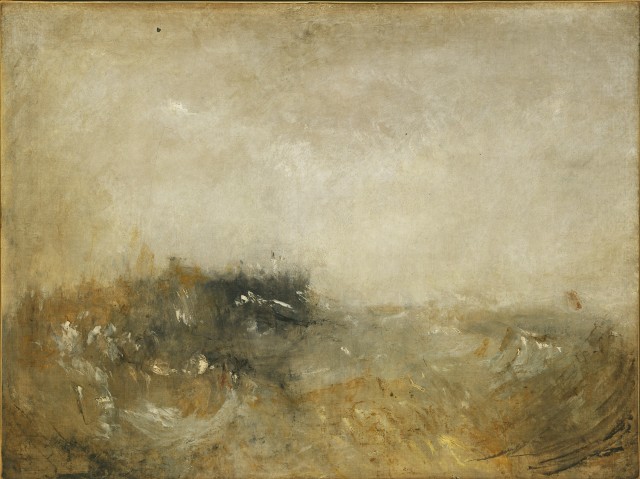
Joseph Mallord William Turner, “Rough Sea,” oil on canvas, ca. 1840-45 (Tate: Accepted by the nation as part of the Turner Bequest 1856)
The centerpiece of the show is a side room — missed by many museumgoers — that contains five glorious later canvases by Joseph Mallard William Turner, abstract seascapes and landscapes painted between 1835 and 1845. Pre-Impressionist, they seem to stand at a sort of gateway to the modern and a transition between earlier ideas of “unfinished” related to product and later notions associated with process. There are few definable objects in the works — “Margate (?), from the Sea,” “The Thames above Waterloo Bridge,” “Rough Sea,” “Sun Setting over a Lake,” and “Sunset from the Top of the Rigi” — and there is debate over whether they are non finito (intentionally unfinished), never completed for various reasons, or in fact finished paintings. Given the experimental nature of the glowing canvases, it wouldn’t have surprised me if Spall walked into the room, carefully surveyed the canvases, then added a dab of paint here, a splotch of color there. It also makes one question whether it even matters if a work is finished or not; without knowing any of the background behind these five Turner paintings, you’d be hard-pressed to consider them unfinished; Turner’s magnificent use of light and color and exquisite brushwork take your breath away, filling every bit of you with emotion, leaving nothing untouched, even if, to Turner, they were not done. As Barnett Newman said, “The idea of a ‘finished’ picture is a fiction.”
The exhibition finishes September 4; be sure to also check out Tatsuo Miyajima’s first-floor installation, “Arrow of Time (Unfinished Life),” which was specially commissioned as a companion piece for the show; it consists of approximately 250 red, numeric LEDs hanging from the ceiling, counting down from nine to one over and over at different intervals, an endless cycle evoking life, death, and rebirth. Miyajima named the piece after Sir Arthur Stanley Eddington’s theory concerning thermodynamics and entropy and was inspired by the Buddhist notion of samsara, which fits right in with the theme of the Breuer’s first major exhibit.

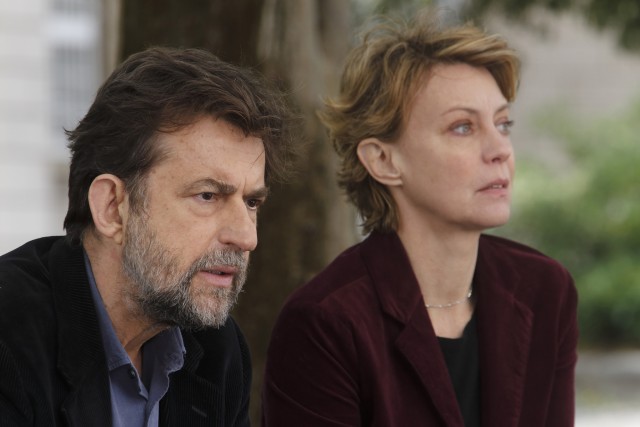
 Several times throughout Nanni Moretti’s semiautobiographical Mia Madre, film director Margherita (Margherita Buy) says, “The actor must be next to the character.” It’s a line that Moretti, the Italian writer, director, and actor behind such international successes as
Several times throughout Nanni Moretti’s semiautobiographical Mia Madre, film director Margherita (Margherita Buy) says, “The actor must be next to the character.” It’s a line that Moretti, the Italian writer, director, and actor behind such international successes as 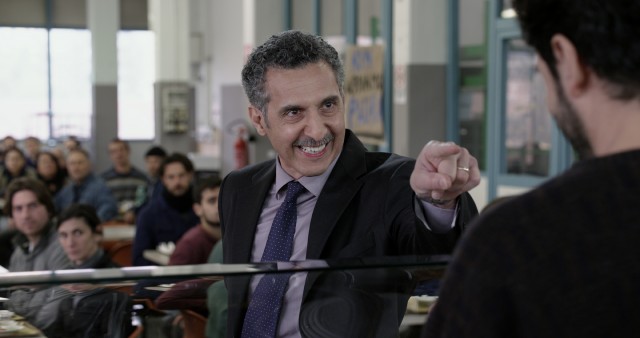


 Inspired by Fatima Elayoubi’s Prayer to the Moon, a collection of writings by a Moroccan woman trying to make a new life for herself and her family in France, Philippe Faucon’s Fatima is a tender, poignant look at the immigrant experience in the twenty-first century. In her film debut, nonprofessional actress Soria Zéroual, who was discovered after a massive talent search, stars as Fatima, a traditional woman raising two daughters in a small Muslim community in France. While her children, Nesrine (Zita Hanrot), who is starting pre-med, and Souad (Kenza-Noah Aïche), a typical disenchanted teenager who prefers hanging out with her friends and flirting with boys rather than studying, speak French and dress in contemporary styles, Fatima converses primarily in Arabic and wears a head scarf. Her ex-husband (Chawki Amari) has remarried, so she has taken on the primary responsibility of raising the kids, working several jobs as a cleaning woman in order to make money to improve their lives and offer them every possibility they deserve. On the surface, Fatima is simple and plain, struggling to communicate with her daughters, her employers, and her doctors. “If my daughter’s a success, my happiness is content,” she tells Nesrine. “You drive me so mad I could go out without a head scarf,” she says to Souad. But Fatima slowly begins revealing that there is much more to her when she picks up a pen and starts sharing her deepest thoughts in a notebook, writing poetry, letters, and short pieces about her life.
Inspired by Fatima Elayoubi’s Prayer to the Moon, a collection of writings by a Moroccan woman trying to make a new life for herself and her family in France, Philippe Faucon’s Fatima is a tender, poignant look at the immigrant experience in the twenty-first century. In her film debut, nonprofessional actress Soria Zéroual, who was discovered after a massive talent search, stars as Fatima, a traditional woman raising two daughters in a small Muslim community in France. While her children, Nesrine (Zita Hanrot), who is starting pre-med, and Souad (Kenza-Noah Aïche), a typical disenchanted teenager who prefers hanging out with her friends and flirting with boys rather than studying, speak French and dress in contemporary styles, Fatima converses primarily in Arabic and wears a head scarf. Her ex-husband (Chawki Amari) has remarried, so she has taken on the primary responsibility of raising the kids, working several jobs as a cleaning woman in order to make money to improve their lives and offer them every possibility they deserve. On the surface, Fatima is simple and plain, struggling to communicate with her daughters, her employers, and her doctors. “If my daughter’s a success, my happiness is content,” she tells Nesrine. “You drive me so mad I could go out without a head scarf,” she says to Souad. But Fatima slowly begins revealing that there is much more to her when she picks up a pen and starts sharing her deepest thoughts in a notebook, writing poetry, letters, and short pieces about her life.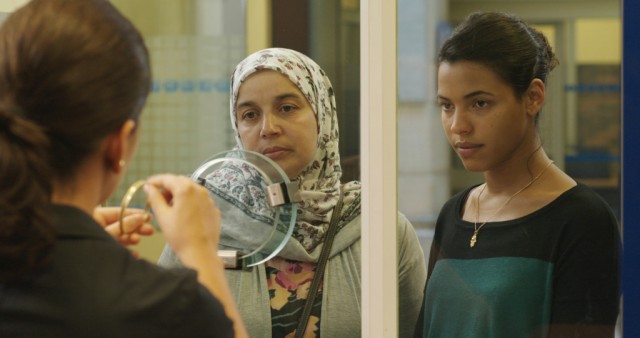



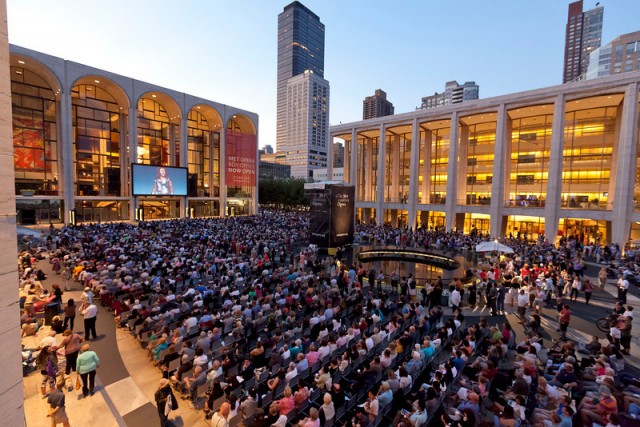
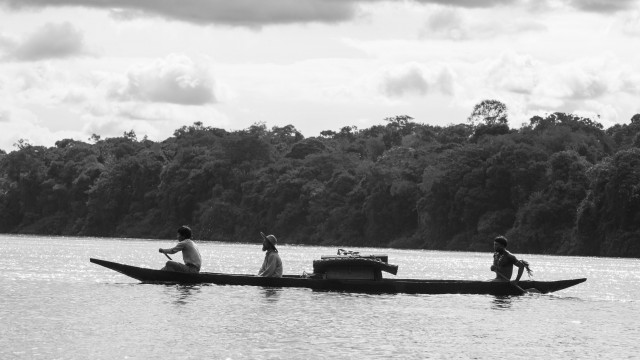
 Colombian writer-director Ciro Guerra takes viewers on a spectacular journey through time and space and deep into the heart of darkness in the extraordinary Embrace of the Serpent. Guerra’s Oscar-nominated film, the first to be shot in the Colombian Amazon in thirty years, opens with a 1909 quote from explorer Theodor Koch-Grünberg: “It is not possible for me to know if the infinite jungle has started on me the process that has taken many others to complete and irremediable insanity.” Inspired by the real-life journals of Koch-Grünberg and botanist and explorer Richard Evans Schultes, Guerra poetically shifts back and forth between two similar trips down the Vaupés River, both led by the same Amazonian shaman, each time guiding a white scientist on a perilous expedition in a long, narrow canoe. Shortly after the turn of the twentieth century, ailing white ethnologist Theo (Jan Bijvoet) and his native aid, Manduca (Yauenkü Migue), seek the help of Karamakate (Nilbio Torres), a shaman wholly suspicious of whites and who believes he is the last of his tribe. However, Theo claims he knows where remnants of Karamakate’s people live and will show him in return for helping him find the magical and mysterious hallucinogenic Yakruna plant that Theo thinks can cure his illness. Forty years later, white botanist Evan (Brionne Davis) enlists Karamakate (Antonio Bolívar Salvador) to locate what is thought to be the last surviving Yakruna plant, which he hopes will finally allow him to dream in order to heal his soul. Evoking such films as Werner Herzog’s Fitzcarraldo and Aguirre, the Wrath of God and Francis Ford Coppola’s Apocalypse Now, Embrace of the Serpent makes the rainforest itself a character, shot in glorious black-and-white by David Gallego (Cecilia, Violencia) in a sparkling palette reminiscent of the work of Brazilian photographer
Colombian writer-director Ciro Guerra takes viewers on a spectacular journey through time and space and deep into the heart of darkness in the extraordinary Embrace of the Serpent. Guerra’s Oscar-nominated film, the first to be shot in the Colombian Amazon in thirty years, opens with a 1909 quote from explorer Theodor Koch-Grünberg: “It is not possible for me to know if the infinite jungle has started on me the process that has taken many others to complete and irremediable insanity.” Inspired by the real-life journals of Koch-Grünberg and botanist and explorer Richard Evans Schultes, Guerra poetically shifts back and forth between two similar trips down the Vaupés River, both led by the same Amazonian shaman, each time guiding a white scientist on a perilous expedition in a long, narrow canoe. Shortly after the turn of the twentieth century, ailing white ethnologist Theo (Jan Bijvoet) and his native aid, Manduca (Yauenkü Migue), seek the help of Karamakate (Nilbio Torres), a shaman wholly suspicious of whites and who believes he is the last of his tribe. However, Theo claims he knows where remnants of Karamakate’s people live and will show him in return for helping him find the magical and mysterious hallucinogenic Yakruna plant that Theo thinks can cure his illness. Forty years later, white botanist Evan (Brionne Davis) enlists Karamakate (Antonio Bolívar Salvador) to locate what is thought to be the last surviving Yakruna plant, which he hopes will finally allow him to dream in order to heal his soul. Evoking such films as Werner Herzog’s Fitzcarraldo and Aguirre, the Wrath of God and Francis Ford Coppola’s Apocalypse Now, Embrace of the Serpent makes the rainforest itself a character, shot in glorious black-and-white by David Gallego (Cecilia, Violencia) in a sparkling palette reminiscent of the work of Brazilian photographer 